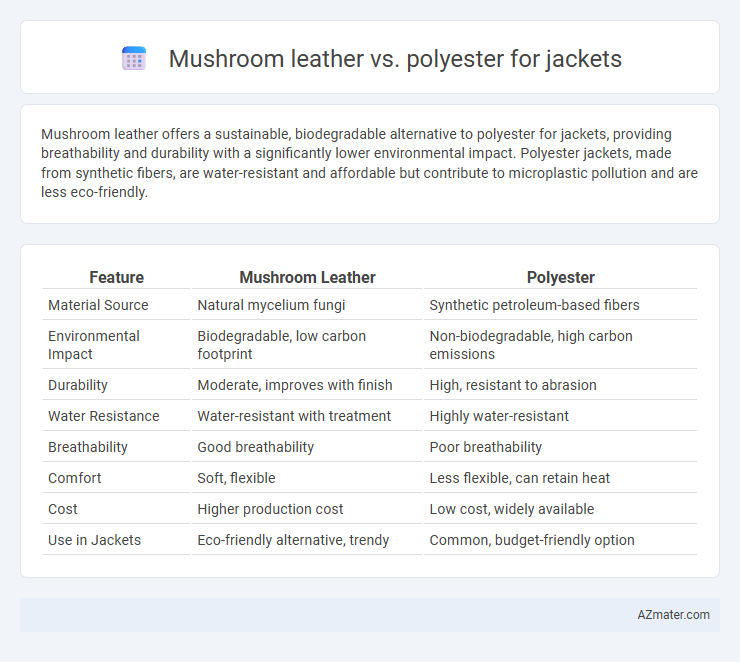Mushroom leather offers a sustainable, biodegradable alternative to polyester for jackets, providing breathability and durability with a significantly lower environmental impact. Polyester jackets, made from synthetic fibers, are water-resistant and affordable but contribute to microplastic pollution and are less eco-friendly.
Table of Comparison
| Feature | Mushroom Leather | Polyester |
|---|---|---|
| Material Source | Natural mycelium fungi | Synthetic petroleum-based fibers |
| Environmental Impact | Biodegradable, low carbon footprint | Non-biodegradable, high carbon emissions |
| Durability | Moderate, improves with finish | High, resistant to abrasion |
| Water Resistance | Water-resistant with treatment | Highly water-resistant |
| Breathability | Good breathability | Poor breathability |
| Comfort | Soft, flexible | Less flexible, can retain heat |
| Cost | Higher production cost | Low cost, widely available |
| Use in Jackets | Eco-friendly alternative, trendy | Common, budget-friendly option |
Introduction to Sustainable Textiles
Mushroom leather, derived from mycelium, offers a biodegradable and eco-friendly alternative to traditional textiles, reducing plastic waste and carbon emissions compared to polyester. Polyester, a synthetic fiber made from petrochemicals, contributes significantly to microplastic pollution and relies heavily on fossil fuels in its production. As the fashion industry shifts toward sustainable textiles, mushroom leather stands out for its renewable sourcing and minimal environmental impact.
What is Mushroom Leather?
Mushroom leather, also known as mycelium leather, is an innovative, sustainable material made from the root structure of fungi, offering an eco-friendly alternative to traditional leather and synthetic fabrics like polyester. Unlike polyester Jackets, which are derived from petroleum and contribute to microplastic pollution, mushroom leather is biodegradable, breathable, and requires fewer resources to produce. The material provides a vegan, cruelty-free option that mimics the texture of animal leather while significantly reducing environmental impact.
What is Polyester?
Polyester is a synthetic fiber derived from petroleum-based polymers, widely used in jacket manufacturing due to its durability, wrinkle resistance, and moisture-wicking properties. It offers high tensile strength and is easy to care for, making it a cost-effective choice for outerwear. However, polyester lacks breathability and is less eco-friendly compared to sustainable alternatives like mushroom leather, which is biodegradable and produced from mycelium.
Production Process Comparison
Mushroom leather is made from mycelium, the root structure of mushrooms, which grows rapidly on organic waste and requires minimal water and no pesticides, making it an eco-friendly and sustainable alternative. Polyester, a synthetic fabric derived from petroleum, undergoes extensive chemical processing, including polymerization and extrusion, leading to high energy consumption and significant environmental pollution. The production of mushroom leather emphasizes biodegradability and low carbon footprint, whereas polyester manufacturing generates non-biodegradable waste and relies heavily on fossil fuels.
Environmental Impact Analysis
Mushroom leather, derived from sustainable mycelium, offers a biodegradable and low-water footprint alternative to traditional synthetic fibers, significantly reducing environmental pollution compared to polyester jackets. Polyester production relies heavily on fossil fuels and emits substantial greenhouse gases, contributing to microplastic pollution during washing cycles. Selecting mushroom leather for jackets supports circular fashion by minimizing landfill waste and chemical runoff, promoting a reduced carbon footprint across the product lifecycle.
Durability and Performance
Mushroom leather offers impressive durability with its natural resistance to wear, flexibility, and breathability, making it a sustainable yet robust choice for jackets. Polyester jackets excel in performance due to their high tensile strength, water resistance, and quick-drying properties, providing superior protection in harsh weather conditions. While mushroom leather combines eco-friendliness with moderate durability, polyester outperforms in long-term wear and weather resilience, ideal for active outdoor use.
Comfort and Wearability
Mushroom leather offers superior breathability and moisture-wicking properties, making it exceptionally comfortable for extended wear compared to polyester, which can trap heat and cause sweating. Its natural flexibility adapts to body movements, enhancing wearability, whereas polyester tends to be less pliable and may result in stiffness. The hypoallergenic and biodegradable nature of mushroom leather also contributes to a more skin-friendly and sustainable choice for jackets.
Cost and Market Availability
Mushroom leather, derived from sustainable mycelium, typically costs more than conventional polyester due to its innovative production process and limited scalability. Polyester jackets dominate the market with widespread availability and lower price points, making them more accessible for mass consumers. The emerging mushroom leather sector is expanding but remains niche, impacting overall market presence and retail pricing compared to polyester alternatives.
Fashion Industry Adoption
Mushroom leather is gaining traction in the fashion industry as a sustainable alternative to traditional polyester jackets, known for its biodegradable properties and lower environmental impact. While polyester remains popular due to affordability and durability, designers increasingly prefer mushroom leather for eco-conscious collections and premium fashion lines. The shift reflects a growing consumer demand for cruelty-free, renewable materials that reduce plastic waste in apparel production.
Future Prospects and Innovations
Mushroom leather presents promising future prospects with its sustainable, biodegradable properties, addressing environmental concerns linked to traditional polyester jackets, which rely heavily on fossil fuels and contribute to microplastic pollution. Innovations in mushroom leather fabrication, such as enhanced durability and water resistance through mycelium cultivation techniques, position it as a competitive alternative in the fashion industry. The continuous development of mushroom-based textiles, combined with advances in biodegradable polyester blends, indicates a shift towards eco-friendly jacket materials emphasizing reduced carbon footprint and improved recyclability.

Infographic: Mushroom leather vs Polyester for Jacket
 azmater.com
azmater.com